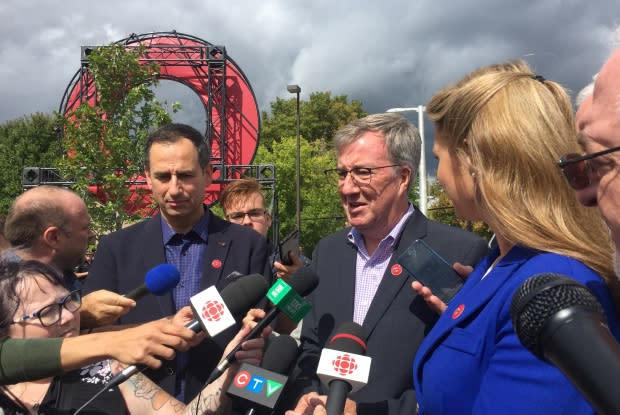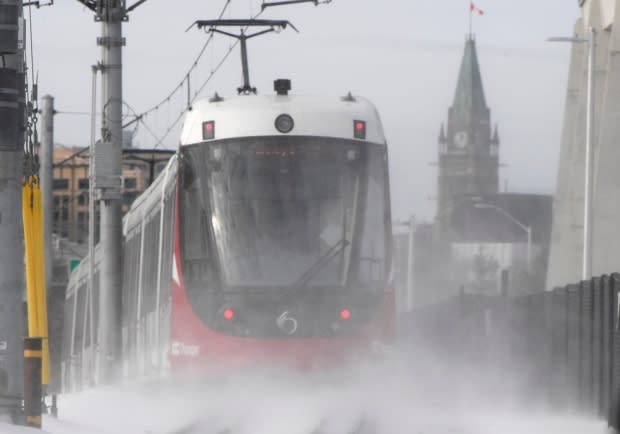LRT marks 1st birthday with few riders — and fewer issues

Reliable and fast. Few delays. Not crowded.
That's how some riders described Ottawa's light rail system last week, and they're not words that would have been used during the darkest times of the Confederation Line's first year.
And with a litany of issues from flat wheels to snagged overhead wires, there were many such times. But as the white-and-red electric trains carry passengers into a second year, the picture is now dramatically different.
"There's nobody on it. It's pretty quiet. You're not worrying about somebody slamming the door open and stopping the train from moving," said rider Jane Phoenix.
"There's plenty of room, plenty of seats, and I feel safe."
The COVID-19 pandemic has emptied the downtown, and the LRT network too. The day after Labour Day — typically one of the busiest times of year — there were just 50 people on one train at Tunney's Pasture during the morning commute, according to John Manconi, Ottawa's transportation boss.
But the many months of low ridership have also allowed Rideau Transit Group, which built LRT and is now maintaining it, to fix many of the problems on the city's to-do list.
"I look back, and as difficult of a year as it was for me, for our staff, our customers and our council ... I sleep comfortably at night," said Manconi. "Because we gave it everything we had, and we're turning a corner."
The 'dark journey'
Manconi was one of the many smiling officials who boarded a train on Sept. 14, 2019, for the ceremonial first ride down the line. But Ottawans' joy with their smooth new train was short-lived.
By early November, Manconi's boss, city manager Steve Kanellakos, would pronounce that Rideau Transit Group had failed the city.
Back then, a key issue was jammed doors — but things went from bad to worse.
A new LRT network might see growing pains, but it's hard to imagine the list of problems the Confederation Line has experienced. Power lines snagged and fell. Winter salt and debris caked onto the overhead power system, teaching Ottawans the term "arc flash". Wheels developed flat spots.
Even as recently as July, wheels cracked, leading the Transportation Safety Board to investigate, and rails warped in the heat.

Through it all, transit officials would hold news conferences and long, tense city meetings, explaining technical details about the growing list of problems but never being able to give a date when people could finally rely on the LRT. Finally in March, the city issued RTG a notice of default, arguing the consortium wasn't living up to its contract.
"We weren't quite sure if we'd hit the darkest part of the darkest part of the journey. We'd turn a corner, and things would pop up," says Manconi now.
RTG now being paid, 15 trains finally running
But within days of that notice came COVID-19 — and breathing space for RTG.
The consortium was not available to comment for this story. But Manconi says RTG has taken advantage of a precipitous drop in ridership to 15 to 20 per cent of normal levels, using periodic shutdowns of the Confederation Line during the pandemic to clear most of the problems, from installing door software to dealing with the overhead wires.
'We never want to repeat a year like last year.' - John Manconi, City of Ottawa's general manager of transportation
One sign of progress is that since August, RTG has finally been running 15 trains, rather than only 13. With service improved, the consortium is also finally getting monthly payments — the city handed it $17.45 million in August.
"They're not done yet. We're not out of the woods. But it's good and it's also relaxed the [OC Transpo] organization," said Manconi.
There's still no firm date for when all problems will be fixed, Manconi said, because work remains on heaters for track switches, for instance.
As for those cracked wheels, Manconi said he plans to tell transit commissioners this week that RTG and train manufacturer Alstom believe they have a solution.
Winter, however, will be the true test of whether the Confederation Line has been cured of its many ailments, Manconi said.
"We never want to repeat a year like last year."
No crystal ball in the time of COVID-19
But bigger questions are down the line, like when will riders come back to fill those trains? When will they start loading money on to their Presto cards?
The city will spend more than $4.5 billion for Stage 2 of the LRT project, when it will be extended to Orléans, Riverside South and Moodie Drive. The plans for Stage 3 will see it further extended to Kanata and Barrhaven.
But is the city building a system for a pre-pandemic era, when commuting downtown to work was the norm, not the exception?
Manconi still thinks the main lines east, west and south will be "needed in perpetuity." As for the short-term, and whether riders will come back this fall, Manconi can't say.
"Everybody in the transit industry around the world is trying to crystal ball where the trend will go," he said.

Federal employees won't be returning to offices for months, and even when they do, they won't come back at once, en masse. University and college students are taking classes online. There's also the fear of a second wave of COVID-19.
For now, the city estimates fare revenues will rise, but only to 30 per cent of the normal levels for the rest of the year. Ottawa's transit department is projected to finish the year $117.5 million in the red.
So as LRT marks a quiet birthday, Manconi says he's "relieved" on one hand. But on the other, he's thinking about how riders and OC Transpo will fare during a pandemic that's changed transit — as it has everything.


